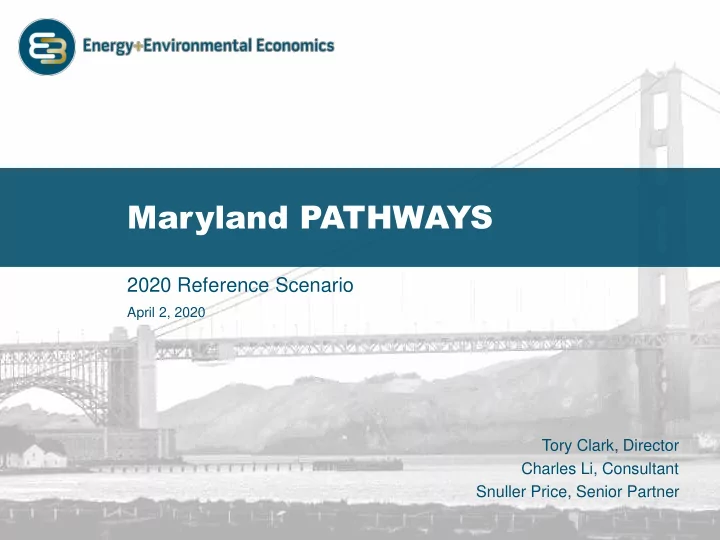

Maryland PATHWAYS 2020 Reference Scenario April 2, 2020 Tory Clark, Director Charles Li, Consultant Snuller Price, Senior Partner
Agenda Background Policies Represented in the Reference Scenario 2020 Updates for the Reference Scenario GHG emissions trajectory and benchmarking Appendix 2
Background The goal of this project is to quantify energy and emissions impacts from Maryland’s current and potential future policies in the E3 PATHWAYS model The PATHWAYS modeling framework allows for: • Detailed tracking of existing and future household appliances and vehicles • Hourly treatment of electricity sector • Comprehensive emissions accounting in buildings, transportation, industry, electricity generation, non-energy, and forestry Reference Scenario (current policy case) was modeled in 2017, Mitigation Scenarios were modeled in 2018-2019. We are now in the process of making final updates in 2020. 3
PATHWAYS Modeling Framework Technology Energy Scenario assumptions Sample Outputs: Demand over time GHG Emissions by Sector and Scenario Energy Demand by Subsector Integrated Emissions Analysis Annual Generation by Electricity Pipeline Supply Fuel Type Supply and Other Fuels Energy Supply by Technology 4 4
Reference Scenario Policies Electricity Generation • Coal facility retirements from latest RGGI Modeling (New Jersey’s rulemaking) • 50% RPS by 2030 (Clean Energy Jobs Act)* • 1.5 GW of rooftop solar adoption by 2026* • RGGI 2030 cap • Relicense Calvert Cliffs Nuclear Facility Transportation • CAFE Standards improving through 2026 • Zero Emission Vehicle Mandate Buildings • EmPOWER efficiency goals as currently established through 2023 • DHCD Low Income EE Program • MEA Woodstoves Program Other • Forest Management and healthy soils sequestration projections *Updated from previous Reference Scenario 5
Updates for the updated 2020 Reference Scenario Sector Updates ▪ Model is benchmarked to 2017 GHG Inventory Global ▪ Updated to emissions based on AR5 GWPs ▪ Space heating and cooling service demand calibrated to Buildings average weather from 2016-2018 ▪ Number of ZEVs are benchmarked to MDOT registration data Transportation through 2019 ▪ ZEV sales and costs updated based on TCI reference scenario ▪ Updated LDV VMT growth rate based on recent data (1.2%) ▪ Cove Point LNG facility added in 2018 (partial emissions in Industry 2018, full emissions in 2019) ▪ Luke Paper Mill closure in 2019 ▪ EIA historical generation data is used to benchmark modeled Electricity generation by coal, natural gas and diesel in 2017 and 2018 ▪ Increased rooftop solar adoption to 1.5 GW by 2026 ▪ Includes 50% RPS by 2030, with solar and offshore wind carve- outs 6
Total Net GHG Emissions The 2020 Reference scenario has much lower GHG emissions than the previous Reference due to more stringent RPS requirement (25% to 50% by 2030) . It overachieves the 2020 GHG target by 3.3 MMT CO2e. It gets much closer to the 2030 GHG target , but there is still a gap of 5.2 MMT CO2. 7
Emissions by Sector Sectoral emissions are also benchmarked to the 2017 Maryland GHG Inventory. The increase in 2018 emissions are mainly due to: • Higher coal and gas generation in 2018 • Increased emissions from the launch of Cove Point LNG Terminal • Increased emissions from buildings because 2017 had very mild weather Previous Reference 2020 Reference 8
Light-duty Vehicles Stock Share: Previous Reference vs. 2020 Reference ZEV stock share in light-duty vehicles is lower before 2030, which is mainly driven by lower ZEV sales in light-duty trucks (LDTs) based on modeling from the Transportation and Climate Initiative (TCI). After 2030, ZEV stock share is significantly higher. Previous Reference 2020 Reference Thousand 2025 2030 Thousand 2025 2030 BEV 204k 391k BEV 120k 390k PHEV 68k 132k PHEV 40k 70k Total ZEV 272k 528k Total ZEV 160k 460k 9
Electricity Generation Solar and offshore wind generation increases over time to meet the RPS carve-outs. Natural gas and coal generation goes up significantly in 2018 based on historical benchmarking. Coal generation in the long term goes down due to more stringent RPS requirement. 10
RPS Updated with CEJA carve-outs for in-state wind and solar Remainder of RPS compliance is met with RECs • In-State RECs account for about 15% of all RECs based on historical data • RPS compliance relies on Out-of-State RECs 11
Next Steps Update Policy Scenario modeling based on feedback Work with RESI at Towson University to update macroeconomic modeling Finish modeling by June 2020 12
Appendix
Building Calibration In order to capture the average weather conditions, we decided to update our analysis to use average weather conditions. • Scenarios starting in 2018 are calibrated to the average weather conditions from 2016-2018 for temperature-dependent building service demand (i.e. space heating and air conditioning) • 2017 had very mild weather, so the model is benchmarked to building energy demand in 2017 for comparing emissions to the state 2017 GHG inventory Historical heating degree days (HDDs) and cooling degree days (CDDs) data from NOAA at BWI (Baltimore/Washington) was applied for the calibration. • Space heating service demand from EIA is adjusted by the ratio of average HDDs in 2016-2018 to those in the year that the EIA data is based on; same for space cooling using the CDDs • We assume the 2015 Residential Energy Consumption Survey, for which data were collected between August 2015 and April 2016, is based on the average 2015 and 2016 weather. • The 2012 Commercial Building Energy Consumption Survey is assumed to be based on 2012 weather. 14
Benchmarked to MD 2017 GHG Inventory All sectors are benchmarked to the state 2017 GHG inventory 15
Historical generation compared to EIA Electricity generation in the 2020 Reference is benchmarked to EIA historical data for Maryland 16
Recommend
More recommend